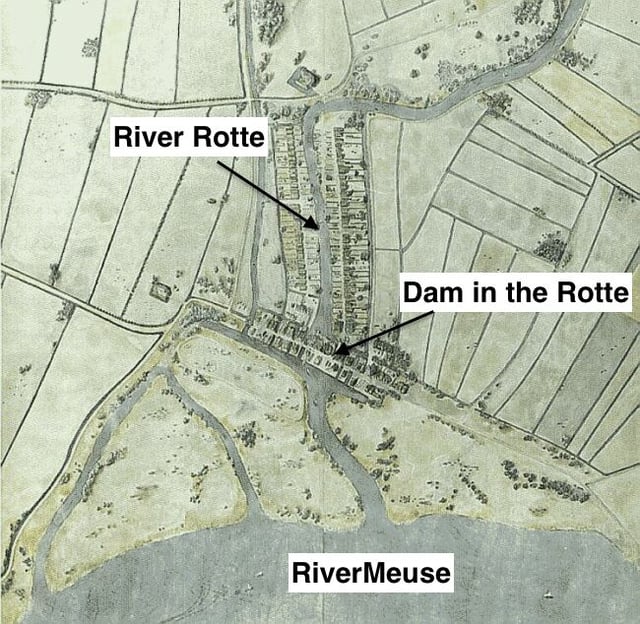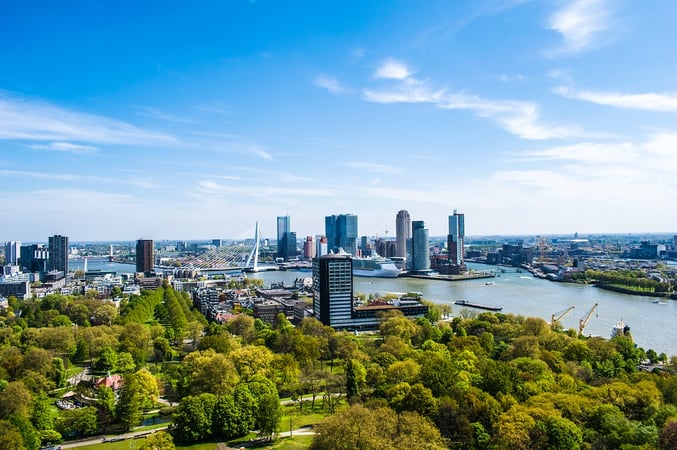Rotterdam: How did they manage to live with water?
Hey there! Did you know that 90% of Rotterdam is below sea level? And it still manages to be a central point in terms of economy? Thanks to good Civil Engineers and Water Managers, Rotterdam was able to grow into the Delta metropolis that it is today.
A History of Adaptations
Since its origins Rotterdam had to adapt to the natural circumstances of the delta, the threat of the rivers and sea waters.
Thanks to the constructions of dams, dykes and land reclamation the dangers and risks of flooding are now under control. Today Rotterdam is one of the safest delta cities in the world, but how exactly did they get here?
The Dam in the Rotte, 1270
Back in 1270, a four hundred meters long dam was built in the Rotte (from here the name Rotterdam). The long dam was full of large wooden structures that allowed boats to sail through and gates that could close if there was the threat for high waters, or the need for drainage.
The dam in the Rotte kept its key function for seven centuries, until 1870, when the Binnenrotte was filled up to allow the construction of a railroad.
 The Dam in the Rotte built in 1270.
The Dam in the Rotte built in 1270.
The Singel Plan, 1854
Most of the canals ("singels") in Rotterdam were constructed in the 19th century, according to the ambitious waterplan of a Dutch engineer, Willem Nicolaas Rose.
Rotterdam's open waters were used both as a sewer and as drinking water resource: this caused cholera epidemics to spread. The singel plan was born to improve the water quality and make it easier to control the water levels.
Since their construction, the canals became one of the urban quality of Rotterdam, and they are still an attractive feature of the city.
 Rose's ambitious Waterplan.
Rose's ambitious Waterplan.
The Maeslant Storm Surge Barrier, 1997
This storm surge barrier was constructed after the disastrous flood of 1953, which caused the death of 1835 people.
The Maeslant storm surge barrier was part of the Delta Works –a series of structures meant to protect the whole Netherlands form the threats of water– and now protects 1.5 million people and the Port of Rotterdam against floods, without interrupting the connection between the port and the sea.
 The Maeslant storm surge barrier with its arms opened.
The Maeslant storm surge barrier with its arms opened.
The Future: is Rotterdam vulnerable?
Due to its density and economical value, Rotterdam will be affected by climate change: the weather will be extreme (heavier rainstorms, higher water levels in the Meuse, longer drought and heat waves).
Rotterdam is located in the delta of the rivers Rhine and Meuse, and via the Nieuwe Waterweg (New Waterway) the city has open links to the sea and is influenced by the tide. A part of Rotterdam, which includes the port area, lies out of the dike. On the inside of the dikes, the city is below sea level. But, as the mayor of the city (Ahmed Aboutaleb) stated: "we do not view climate change as a threat, but as an opportunity to make the city more resilient, more attractive, and economically stronger".
Climate change adaptation provides a multitude of opportunities to strengthen the economy of the city and its port, to increase the biodiversity in the city and to encourage the people of Rotterdam to become involved and actively participate in society. The city developed the Rotterdam Climate Change Adaptation Strategy, to make Rotterdam "climate proof" by 2025.
 A view of Rotterdam and all of its water.
A view of Rotterdam and all of its water.
Stay tuned for a blog about how Rotterdam is planning to adapt to climate change and become what they call a "climate proof" city.
Rotterdam is only one of the many examples of how the Dutch learnt to successfully deal with water, and how they earned the title of water experts.
If you are interested in the topic and want to learn more about how Civil Engineering and Water Management can help solve problems in urban areas I advice you to check out our study programmes.
Resources:
- City of Rotterdam.(October, 2013). Rotterdam, Climate Change Adaptation strategy. Retrieved from http://www.rotterdamclimateinitiative.nl/documents/2015-en-ouder/Documenten/20121210_RAS_EN_lr_versie_4.pdf
- Plezierriver de Rotte. (n.d.). De Rotte Dam: Story. Retrieved from https://derotte.nl/verhalen/de-rotte-dam/
- Geemente Rotterdam. (n.d.). Water in Rotterdam. Retr https://www.rotterdam.nl/wonen-leven/water-in-rotterdam/

